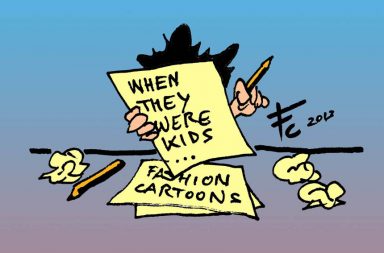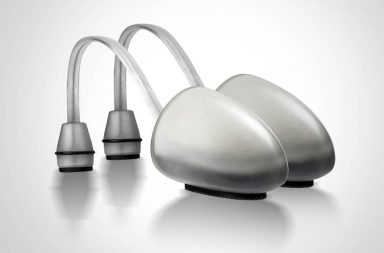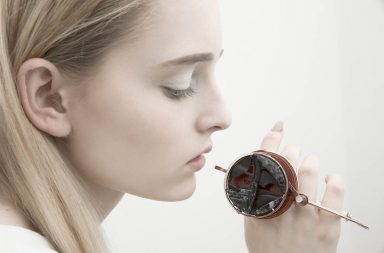To talk about the work of the Dutch artist Anne Fleur van der Vloed is to immerse yourself in a world of beauty and pain.
At the young age of six she enjoyed drawing fashion figurines and helping her grandmother get dressed and put outfits together. That’s where she learned that fashion can help people feel better.

After secondary school she entered the Willem Willem de Kooning Academy in Rotterdam before she completing her studies with a Master’s in Fashion Artefacts at the London College of Fashion, thanks to a scholarship she received from her home country and an award known as the Procter & Gamble Better Lives Award (which she won while studying).
The world of Anne Fleur dances on the delicate edge of fashion and art, where beauty and conceptual ideas live together in harmony.
Her work “Bodily” is pure autobiography. Anne Fleur talked to us at So Catchy! Where Fashion Begins recently and we learned a bit more about her life and the fascinating world of fashion artefacts.

SO CATCHY!: A lot of people could be confused by the use of the word “fashion” in your work… How would you explain it to them?
Anne Fleur van der Vloed: What I found out during my Bachelor is that Fashion is not limited to wearable clothing but is a tool to communicate. Not everyone wishes to or is able to communicate with clothing but I believe everyone can relate with the human body even if it is in its abstract like my current collection.

SC!: Why did you focus on fashion artefacts? It seems it is a width world… a lot of things can fix into the description of fashion artefact.
AF: For me that is the beauty of fashion artefacts. To be able to create fashion artefacts you need to be very open minded and up-to-date about everything from politics to fashion technology and from culture to craft making.
For some people it might be a lot to absorb but personally I work better when I don’t have any limitations and where I can challenge myself to make the intangible views of the world visible in my work.
I believe the difference to other disciplines and also what is really fashion related is the research and development what go’s in the crafts used to develop the works. You need to be very disciplines to learn different crafts in a short time but also experiment on how to develop your own crafts and combining them.

SC!: Could you describe your creative process?
AF: Although I enjoy being informed about what’s going on in the world on a wide range of topics. Everything I do is on intuition, for me that is the most important thing. However, I always try to be open-minded regarding other people’s thoughts when my work is discussed.
After I have a feeling of an idea I visualize colors, materials and shapes in my head and then I start sketching and find (cheap) materials to create the shapes. This way my designs go beyond my imagination because I work much more spontaneously and can feel the materials.

SC!: Let’s talk about your final collection (name?) and your chronic pain. Was it a kind of therapeutic process?
AF: My final collection is my first autobiographical work called Bodily. I lived with chronic pain in my neck and back for several years now and nobody really knows why I feel this pain. I can only make it better with exercise, listening to my body and going to physiotherapy.
When I started with my MA I was thrown out of balance because I was in a different country and did a lot of physical work so my pain started taking control of my life. To take the control back I started researching other people who live with chronic pain and often the pain takes over their life because they lost hope. I felt I needed to help them but also myself to create hope for the future.
I wanted to make the pain visible but still show my personal identity. Personally I have always put beauty on display to contrast the feeling of pain it is a way of making me feel better from the inside. The grooming process helps me take over control of the pain because I don’t feel like a disabled person and have never acted like one.
To make the pain visible was a very scary thing to do because most people didn’t know about it. However, it was also very relieving to make the pain visible in combination with putting the beauty on display. When I now look at the work I see strange beautiful objects loaded with the restriction of pain but the hope of possibilities.

SC!: What materials you used ? Tell us about the manufacturing process you followed.
AF: To create the shapes, I made different models with chicken wire and covering them with plaster bandages. I positioned myself against the shapes in different positions who make my pain worse but also make my pain less.
In the summer I feel less pain because its nice and warm and I don’t need to wear heavy clothing which always feel very restricted to me so those sculptures are smaller and less heavy but in the winter the pain is worse and the pieces are heavy and big.
When the shapes felt right I covered them with oil based clay and smoothed them out with the warmth of my fingers to get the desired surface.

For the final objects I wanted to use a two-component bio resin and fiber glass because when it’s dry its really hard and I wanted the sculptures hard and smooth. I needed to make molds for each piece to replicate them in the other material; BIO resin. I choose bio resin because its much better for the environment but also for myself to work with compared to normal resin.
The mold making was really difficult and took me a lot of time so I had help from professional mold makers to work in my strict time schedule.
When the molds and the bio resin replica’s where finished the physical work started. I needed to sand al the resin pieces to get writ of scratches what took me, my mom and the first years over 4 weeks to finishes. Without them it would not have been possible.

During this period the objects where spray-painted several times to see if the surface was smooth enough or needed more sanding.
After the surfaces where smooth I went to two different spray-painters and a spray-paint shop to mix the perfect skin tones for each different piece. What was quit funny because it was a car paint shop and I came with samples from my own make up colors during the year.
To get the bodily aspect even better I worked with leather molding for some of the pieces. This technique is used in horse saddles.
An other technique I used was rooting hair in silicone. The technique is used by Re-Borners who make really life like baby dolls. I experimented with different hair types and different kind of silicon and in the end I used human hair colored by my own hair dresser who colored the hair in different colors for each piece.
SC!: Where do you think the future of fashion is heading?
AF: I don’t believe that people can keep going on the way they do now. Clothing is become as replaceable as a piece of gum and most of the quality is “social media quality” what means good with a filter not good in real life!!
During my MA I had the opportunity to be apart of the Kering Empowering Imagination module what really brought me hope for the future of fashion. Kering is a big big company with brands from Stella Mccartney to Gucci under its wings and strongly believe that they need to give back to the environment.
Personally I find it very beautiful to know “the story” behind a product from knowing where the materials come from to what circumstances the people had to work to make the product.
SC!: Do you plan to create wearable pieces anytime soon?
AF: I already believe in some way this are wearable pieces.

SC!: Your Next Step is…
AF: At the moment I am working on abstract mannequin frames to hold the pieces in position for my upcoming exhibitions. The first planned exhibitions are the 30th of June at Fashion Clash in Maastricht, The Netherlands and during London Design week. Also I am busy with create my own exhibition at the chronic pain department of a hospital in the Netherlands but I can’t say much more about that yet.
SC!: Your main inspiration is….
AF: Everything to do with humans, I know this is broad again but I find people’s minds, behavior and their bodies deeply inspiring. Besides that, I get my inspiration from different materials and experimenting with them.
SC!: Your dream is….
AF: Being part of an exhibition in my favorite museum The Boijmans van Beuningen in Rotterdam, The Netherlands. My mentors at London College were part of a 2009 exhibition; The art of fashion and a fellow Artefact student in 2015. That has always been a really big dream!! But the exhibition what I am working on in the hospital where I might can inspire someone who lost hope would be amazing too!!!
SC!: Instagram accounts or website you like.
AF: I am always browsing on Instagram but some how I don’t look at the wall of people I follow. Aniara Art, Honeylong, thingspowerthemselves, YKK London showroom, Zharkobasheski, etc, are people I do look at.
SC!: Your favorite artist is / are….
AF: Naomi Filmer, Jo Cope (you can read the interview Jo gave us here), Gabriel Camelo, Jana Zornik, Berlinde de Bruyckere, Hans Belmer, Viktor&Rolf, Lucy McRae, Asger Carlsen.
SC!: You cannot live without…
AF: Mentos pure fresh chewing gum and earplugs!!!
Images courtesy of Anne Fleur
Translation and layout by Michael Padilla





